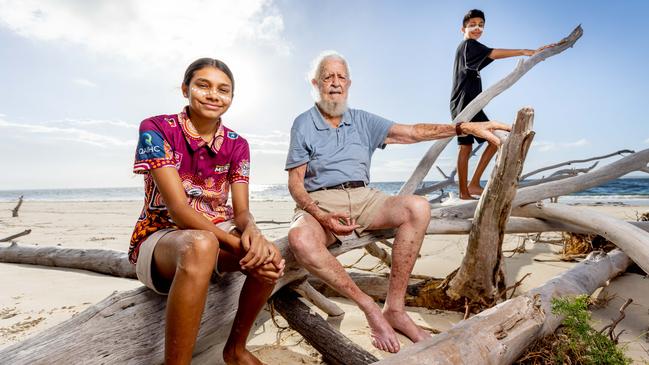Step forward on path to Indigenous treaty
Ngugi elder Bob Anderson is again taking a leadership role in the next step of ‘the journey’ away from the days of segregation and institutionalised racism.

As an Aboriginal boy in Brisbane, Bob Anderson lived in fear of being caught out and about inside the “boundary” – the three streets of that name that still exist on the edges of the city – where Indigenous people were banned at night and on Sundays.
Now 93, the pleadings of his mother to be home before dark still echo in the mind of the Ngugi elder, as he again takes a leadership role in the next step of “the journey” away from those days of segregation and institutionalised racism.
The longtime activist, former carpenter and original native title claimant to Mulgumpin (Moreton Island) will help front the release on Tuesday of a report setting out the path to a treaty between Queensland and its First Nations’ people.
It will include the creation of a First Nations Treaty Institute to work on the agreement, and a three-year “Truth Telling and Healing Inquiry” to publicly air past injustices.
Queensland is one of several jurisdictions – including Victoria and the Northern Territory – to pursue a treaty in parallel to the national debate over constitutional recognition for Aboriginal and Torres Strait Islander people and the proposed voice to parliament.
The report, first handed to the state government last October and the subject of criticism by its Aboriginal co-author, Jackie Huggins, over the delayed release, has been wholly endorsed by Annastacia Palaszczuk and her cabinet.
For Uncle Bob, the treaty or treaties – with the government already signalling there may be different agreements with different groups across the state – is important for Indigenous and non-Indigenous people.
“It is part of the journey to set out where we are going, walking together, talking together as a nation and sharing a common destiny,’’ he said.
Uncle Bob, whose clan is one of three that makes up the Quandamooka people of Moreton and Stradbroke islands, said that the “Truth Telling” inquiry should not be about blame but “acknowledging what happened in the past”.
“I have seen so much change since I was a boy when there was the curfew on the streets,’’ he said.
“The treaty and constitutional recognition, which is a must, is part of the progression of our great nation with its multiculturalism and it begins with valuing Aboriginal culture.’’
The government put aside $300m last year in the budget for the “Path to Treaty Fund” for the process.
Three years ago, the Palaszczuk government started talks about a proposed treaty and later set up a treaty advancement committee co-chaired by Dr Huggins, a historian and author, and former Aboriginal and Torres Strait Islander social justice commissioner of the Australian Human Rights Commission Mick Gooda.
The committee, which also included former Brisbane lord mayor Sallyanne Atkinson, has made 22 recommendations that begins with the establishment of an interim body of Indigenous leaders and non-Indigenous representatives.
Ms Palaszczuk said the treaty was a historic leap toward reconciliation in the state.
“We can’t change the past, but together we can create a new future for our state,” the Premier said.
“Treaty is about finding a place where we can face up to our shared history and be truthful about all of it – good and bad – and build a future together where we value, trust, and respect each other.”
Aboriginal and Torres Strait Islander Partnerships Minister Craig Crawford said he believed there was a “momentum” of support across the state for the treaty.
“An Independent Interim Body (IIB) consisting of Aboriginal and Torres Strait Islander leaders as well as non-Indigenous representatives, will be in place for the next 12 to 18 months as we develop the legislation to establish the First Nations Treaty Institute and Truth Telling and Healing Inquiry,’’ he said.
“The IIB will first lead local truth telling initiatives including with public libraries, museums, archives and art galleries to promote a shared understanding and why it’s important to know our history.”
Earlier this year, Dr Huggins told the ABC that she was “frustrated” with the delays in the release of the report.
In a statement on Friday she said her report on The Path to Treaty “is about how we mend the very fabric of our society”.
“We want all Queenslanders to walk side-by-side with us on the Path to Treaty, so that we can overcome those huge injustices that still, unfortunately, persist in our society,’’ Dr Huggins said.
The proposed treaty and its direction has been previously questioned by some Indigenous leaders.
Cape York leader Gerhardt Pearson, who had attended a public meeting of the treaty advancement committee, last year said the treaty direction lacked practicality.
“The question I have is how does this treaty benefit and advance our people, our children, our old people?’’ he said.
And in 2020, the executive of the Queensland Indigenous Labor Network, which had initially pushed the treaty, said an earlier report on how to pursue a treaty showed elements of the process being “hijacked” by personal and political agendas.
Five of the eight-member network executives later resigned.




To join the conversation, please log in. Don't have an account? Register
Join the conversation, you are commenting as Logout